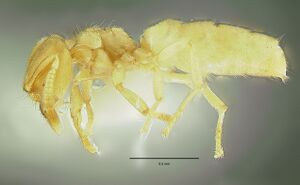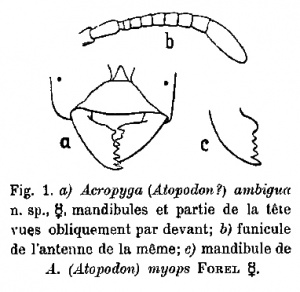Acropyga ambigua
| Acropyga ambigua | |
|---|---|

| |
| Scientific classification | |
| Kingdom: | Animalia |
| Phylum: | Arthropoda |
| Class: | Insecta |
| Order: | Hymenoptera |
| Family: | Formicidae |
| Subfamily: | Formicinae |
| Tribe: | Plagiolepidini |
| Genus: | Acropyga |
| Species group: | myops |
| Species: | A. ambigua |
| Binomial name | |
| Acropyga ambigua Emery, 1922 | |
LaPolla (2004) - Collected in rainforest from leaf litter and soil cores. It has been reported as being trophophoretic and been associated with 3 mealybug species: Eumyrmococcus kusiacus, E. neoguineensis, Xenococcus acropygae (Williams, 1998).
Identification
LaPolla (2004) - A member of the Acropyga myops species group. Worker: 9-11 segmented antennae; basal tooth separated from other teeth by a distinct diastema; basal tooth margin distinct and not smoothly continuous with inner mandibular margin, slightly below inner mandibular margin. Queen: as in worker with modifications expected for caste. Male: unknown. Compare with Acropyga pallida.
Workers of this species can be difficult to distinguish from Acropyga pallida, especially if a specimen is on the lower end for head width measurements. Examination reveals morphometric differences between the two species. Typically A. ambigua head width is greater than 0.45 mm, while A. pallida is less than 0.45 mm, although exceptions occur. Smaller individuals of A. ambigua are difficult to distinguish because the mandible, which is distinct in larger individuals can become similar to the A. pallida mandible type, that is in lacking a distinct diastema associated with the basal tooth. Another problem arises in that A. pallida specimens can form diastemas between the 4th and basal tooth as a result of dental abrasion. When this occurs and the head width is below 0.45 mm the specimens are nearly impossible to separate between the two species, though plotting head width against head length can be helpful.
Keys including this Species
Distribution
Latitudinal Distribution Pattern
Latitudinal Range: -3.066666667° to -8.883330345°.
| North Temperate |
North Subtropical |
Tropical | South Subtropical |
South Temperate |
- Source: AntMaps
Distribution based on Regional Taxon Lists
Indo-Australian Region: Borneo, Indonesia, Malaysia, New Guinea (type locality).
Distribution based on AntMaps
Distribution based on AntWeb specimens
Check data from AntWeb
Countries Occupied
| Number of countries occupied by this species based on AntWiki Regional Taxon Lists. In general, fewer countries occupied indicates a narrower range, while more countries indicates a more widespread species. |

|
Estimated Abundance
| Relative abundance based on number of AntMaps records per species (this species within the purple bar). Fewer records (to the left) indicates a less abundant/encountered species while more records (to the right) indicates more abundant/encountered species. |

|
Biology
Castes
Males are not known for this species.
Worker
   
| |
| . | Owned by Museum of Comparative Zoology. |
Phylogeny
| Acropyga |
| ||||||||||||||||||||||||||||||||||||||||||||||||||||||||||||||||||||||||||||||||||||||||||||||||||||||||||||||||||||||||||||||
Based on Blaimer et al., 2016. Note only selected Acropyga species are included, and undescribed species are excluded.
Nomenclature
The following information is derived from Barry Bolton's Online Catalogue of the Ants of the World.
- ambigua. Acropyga (Atopodon) ambigua Emery, 1922d: 107, fig. 1a-b (w.q.) NEW GUINEA (Papua New Guinea).
- Type-material: 2 syntype workers, 1 syntype queen.
- Type-locality: Papua New Guinea (“NE New Guinea”): Friedrich-Wilhelmshafen (= Madang) (L. Biró).
- Type-depository: HNHM.
- Status as species: Emery, 1925b: 30; Stärcke, 1930: 376 (in key); Chapman & Capco, 1951: 211; Bolton, 1995b: 57; LaPolla, 2004a: 60 (redescription); Pfeiffer, et al. 2011: 36.
- Distribution: Indonesia (Irian Jaya), Malaysia (Sarawak), Papua New Guinea.
Unless otherwise noted the text for the remainder of this section is reported from the publication that includes the original description.
Description
Worker
LaPolla (2004) - (n=17): TL: 1.52-1.96; HW: 0.402-0.518; HL: 0.395-0.571; SL: 0.281-0.413; ML: 0.402-0.516; GL: 0.656-0.93; CI: 88.71-101.07; SI: 68.37-84.63.
Head: yellow; head covered in layer of appressed hairs, with occasional scattered suberect to erect hairs, especially along posterior margin; head longer than broad, though occasionally as long as broad; posterior margin entire; 9-11 segmented, incrassate antennae; scape reaches or slightly fails (approximately less than half length of pedicel) to reach posterior margin; clypeus broad, slightly convex medially; clypeus with appressed to erect hairs; mandible broad, with 5-6 teeth; basal tooth separated from other teeth by a distinct diastema in which a small tooth occasionally develops (making mandible 6-toothed); 4th tooth (from apical) often separated from 3rd tooth by a short diastema, in which a small tooth occasionally develops (making mandible 6 toothed); basal tooth margin not smoothy continuous with inner mandibular margin; anterior clypeal margin and inner mandibular margin nearly parallel. Mesosoma: yellow; in lateral view, pronotum rises steeply toward mesonotum; pronotum with short appressed to suberect hairs throughout, longer erect hairs on posteriorly; mesonotum often rounded, slightly higher than propodeum; dorsum covered in layer of short appressed hairs with suberect to erect hairs throughout and of variable lengths; metanotal area distinct; propodeal dorsum with short appressed to suberect hairs; declivity steep. Gaster: petiole thick and erect, apex reaches height of propodeal spriac1e; gaster yellow; covered in thick layer of appressed hairs with scattered erect hairs throughout.
Queen
LaPolla (2004) - (n=1): TL: 3.13; HW: 0.668; HL: 0.651; SL: 0.489; ML: 0.912; GL: 0.912; CI: 102.61; SI: 73.2. As in worker with modifications expected for caste and the following differences: color dark brown throughout; head broader than long.
Type Material
LaPolla (2004) - Acropyga (Atopodon) ambigua Emery, 1922: 107 (w.q.). 2 syntype workers, 1 syntype queen, PAPUA NEW GUINEA: N.E.: Friedrich-Wilhelmshaften (L. Birö) (probably in Hungarian Natural History Museum) [not examined).
References
- Emery, C. 1922e. Quelques fourmis nouvelles minuscules. Ann. Hist.-Nat. Mus. Natl. Hung. 19: 107-112 (page 107, fig. 1 worker, queen described)
- LaPolla, J.S. 2004a. Acropyga of the world. Contributions of the American Entomological Institute. 33(3):1-130. (page 60, worker described, subgeneus removed)
- Williams, D J . 1998. Mealybugs o f the genera Eumyrmococcus Silvestri and Xenococcus Silvestri associated with the ant genus Acropyga Roger and a review of the subfamily (Hemiptera, Coccoidea, Pseudoccidae). Bulletin of the British Museum (Natural History)(Entomology) 67: 1 -64.
References based on Global Ant Biodiversity Informatics
- Blaimer B. B., J. S. LaPolla, M. G. Branstetter, M. W. Lloyd, and S. G. Brady. 2016. Phylogenomics, biogeography and diversification of obligate mealybug-tending ants in the genus Acropyga. Molecular Phylogenetics and Evolution 102: 20-29.
- CSIRO Collection
- Emery C. 1922. Quelques fourmis nouvelles minuscules. Annales Historico-Naturales Musei Nationalis Hungarici 19: 107-112.
- Janda M., G. D. Alpert, M. L. Borowiec, E. P. Economo, P. Klimes, E. Sarnat, and S. O. Shattuck. 2011. Cheklist of ants described and recorded from New Guinea and associated islands. Available on http://www.newguineants.org/. Accessed on 24th Feb. 2011.
- Janda M., P. Matos-Maravi, M. Borovanska, J. Zima Jr., E. Youngerman, and N. E. Pierce. 2016. Phylogen y and population genetic structure of the ant genus Acropy ga (Hymenoptera : Formicidae) in Papua New Guinea. Invertebrate Systematics 30: 28-40.
- LaPolla J.S. 2004. Acropyga (Hymenoptera: Formicidae) of the world. Contributions of the American Entomological Institute 33(3): 1-130.
- Lucky A., E. Sarnat, and L. Alonso. 2011. Ants of the Muller Range, Papua New Guinea, Chapter 10. In Richards, S. J. and Gamui, B. G. (editors). 2013. Rapid Biological Assessments of the Nakanai Mountains and the upper Strickland Basin: surveying the biodiversity of Papua New Guineas sublime karst environments. RAP Bulletin of Biological Assessment 60. Conservation International. Arlington, VA.
- Lucky A., L. E. Alonso, E. Sarnat, and J. Hulr. 2015. Ants and scolytine beetles. In: Richards, S.J. and N. Whitmore (editors) 2015. A rapid biodiversity assessment of Papua New Guinea's Hindenburg Wall region. Wildlife Conservation Society Papua New Guinea Program. Goroka, PNG.
- Pfeiffer M.; Mezger, D.; Hosoishi, S.; Bakhtiar, E. Y.; Kohout, R. J. 2011. The Formicidae of Borneo (Insecta: Hymenoptera): a preliminary species list. Asian Myrmecology 4:9-58


